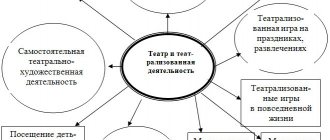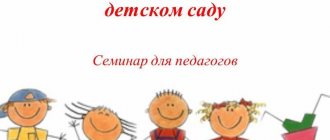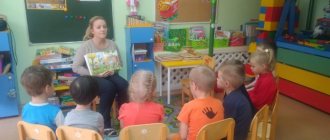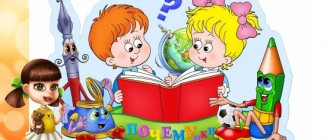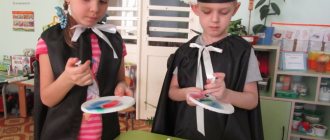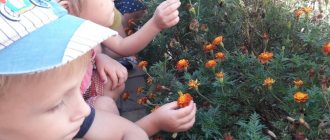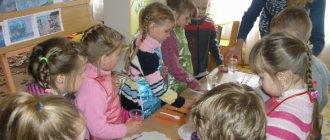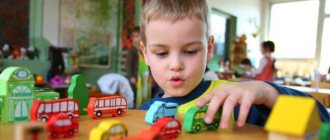Experimental activities in kindergarten: tasks, methods and techniques
Oksana Shelkoplyas
Experimental activities in kindergarten: tasks, methods and techniques
Experimental activities in kindergarten
A preschool child actively strives to learn as much as possible about the world around him. Along with play activity, cognitive activity , during which the ability to form initial forms of generalization and inference is formed. Children become interested when they themselves can discover new properties of objects , their similarities and differences, giving them the opportunity to acquire knowledge on their own.
The Federal State Educational Standard for preschool education sets modern teachers the task of creating conditions for the child’s development that open up opportunities for his positive socialization, his personal development, the development of initiative and creative abilities based on cooperation with adults and peers and age-appropriate activities . We believe that experimental activities , along with play, contribute in the best way to solving this problem , since these two types of children's activities have a significant impact on the full, comprehensive development of the child’s personality. The correct organization of these two truly children's activities is a favorable condition for the development of preschool children.
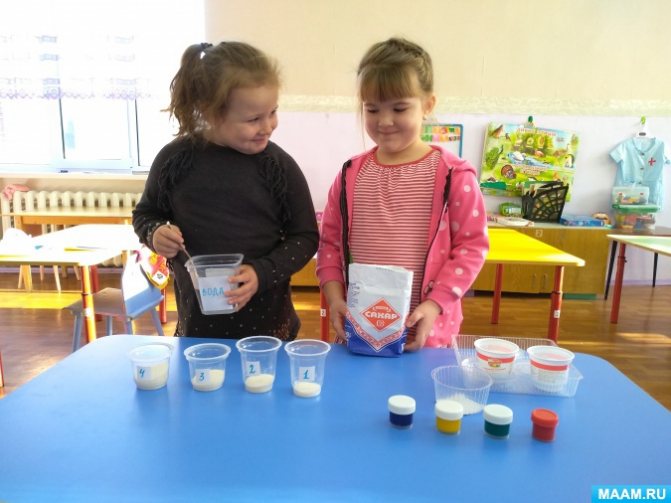
Experimentation is a method of understanding the patterns and phenomena of the surrounding world and relates to cognitive and speech development. The child’s need to learn every day lies in the new impressions that he can receive, and the process of training and education in kindergarten is precisely aimed at revealing in the child’s personality those qualities that he will need to achieve any goals in the future. Developing an inquisitive mind, introducing people to the properties of objects through direct observation of phenomena and processes, developing the ability to plan and analyze practical work - these are the tasks of the modern education system. A child is capable of independently searching for knowledge if the teacher has prepared the appropriate conditions for this.
The modern education system in kindergarten is moving away from the method of transmitting knowledge to children using the information method (direct transmission from teacher to student)
.
The goal of experimental activities in preschool educational institutions is to form and expand children's ideas about objects of living and inanimate nature through practical independent knowledge.
The teacher works in this direction during educational activities, on walks, thematic leisure activities, and motivates experimentation in independent activities . For experimental research, a subject-spatial environment is organized: a research corner, an experimentation or a mini-laboratory is created. Children's experimentation is in many ways similar to scientific experimentation; children experience positive emotions from the feeling of the importance of the work done, obtaining visible results, and new information.
Objectives of experimental activities in preschool educational institutions
Educational objectives
Formation of an idea about objects: their properties and qualities.
Forming the ability to determine relationships between objects and phenomena.
Formation of the ability to draw conclusions and discoveries.
Developmental tasks
Development of thinking abilities: comparison, comparison, systematization, generalization, analysis.
Development of fine motor skills and coordination of movements.
Development of visual, auditory, sensory perception.
Development of attention and memory.
Development of speech abilities.
Educational tasks
Creating positive motivation for independent experimentation .
Creating a friendly atmosphere in the group during research.
Developing the ability to work in a team and a sense of mutual assistance.
Cultivating perseverance and accuracy.
Methods and techniques of experimental activities in preschool educational institutions
Among the techniques and methods for organizing experimental activities, we will highlight those that are relevant for use in a preschool educational institution:
• Problem-search method . The teacher creates a problem situation in which children have to identify issues that need to be solved, put forward hypotheses on how to solve the problem, conduct experimental activities and draw conclusions . The problem-search method is the leading one for the modern education system, in which, through a lively discussion with the teacher, children become motivated to actively experiment and strive to get results.
• Observations of the object. organized indoors or on the territory of the kindergarten develops the visual and auditory abilities of children. Explorations carried out during walks immerse children in the natural world with all its diversity of sights, colors, sounds and smells. Observation is one of the active practices of experimental research activities among preschoolers .
• Experiences and experiments . Along with play, experimentation is considered a leading activity . By performing elementary experiments on objects (dropping them on the floor, trying to break them, extracting a sound, etc.), kids acquire information about their properties. Preschoolers are happy to participate in experiments on familiar substances, deepening their knowledge: they conduct experiments with water in liquid and solid states , with sand, stones, clay, plants. You need to start conducting experiments with children of the younger group, encouraging the desire for independent experimentation . This method of research activities develops observation, activity, independence in children, contributes to the formation of a friendly atmosphere and team cohesion .
In experimental activities, the development of children's mental and practical abilities is carried out. If during the research process the task was to obtain new information by improving practical skills, then the experimental activity in this case is cognitive in nature. experimentation skills and training to work with various tools is carried out within the framework of research experimental activities .
Types of Experimentation
• Experimental games . Since the leading activity of preschool children is play, the first experiments and experiments are carried out in line with the play orientation. During the lesson there is a fairy-tale character who gives the children tasks or asks for help in a problem situation. It is possible to create a game situation where children will act in imaginary conditions (the kingdom of snow and ice, visiting the Fairy of the Air, etc.)
.
• Simulation. knowledge about the properties of objects through studying or building models of real-life objects (volcano, iceberg, aurora)
.
of modeling in experimental activities (for example, they model a vortex using the power of pieces of paper and creating an air flow; it is important for the teacher to take into account the age characteristics of children; the model must be understandable and accessible.
• Experiments. Conducting experiments allows in a visual form explain physical phenomena in classes on the surrounding world. It is necessary to provide instructions on working in a mini-laboratory or experimenting in the workplace , discuss safety rules together with the students. Independent experimentation is more vividly imprinted in the child’s memory. Preschoolers conduct experiments with water, air, various types soil, magnets. Complex types of experiments in kindergarten are usually aimed at expanding ideas about the properties of soil, water, air. Complex experience allows you to deepen knowledge about water (the ability to dissolve)
and obtain information about other substances
(butter, flour, salt)
Methods for recording the results of children's experimentation : Recording the results of practical research or observation is a mandatory stage of experimental activity . Children need to be taught to fixate gradually, since this type of work is considered difficult for preschoolers. And this stage is necessary so that the results of the experimentation are imprinted in the pupils’ memory (visual, sensory, auditory, motor, olfactory)
.
1. Graphic. The simplest way to record results visually using ready-made forms: cards, pictures, graphic diagrams, photographs, three-dimensional images, audio recordings. This method can be used in experimenting with children 3–4 years old , asking them to choose from several ready-made forms the one that represents the results of practical work in the current lesson. With pupils of the middle group, simple graphic diagrams or mnemonic cards are used.
2. Mental. To record the results of experimental activities, children's speech skills are used: the child talks about the results of practical research. The mental method is used in working with children of the middle group: students develop the ability to independently pronounce the results of the experiment , compare them with the results of similar experiments conducted earlier. During mental fixation, older preschoolers improve their ability to generalize and systematize knowledge about objects.
3. Practical. It consists of recording the results of experimentation on paper - by sketching or writing. When working with preschoolers, schematic sketching and sketching with conventional symbols are more often used. For this purpose, children keep observation diaries, experiment logs, and fill out experiment . writes down a story about the results of practical research in kindergarten from the words of the children, for example, to secure a report on the work done in the group journal, on a stand in the knowledge corner.
Preschool children have a strong desire for observations, direct contact with the objects being studied, and conducting experiments . They are especially attracted to classes in mini-laboratories, where they can use special tools and unusual materials for research.
It is important for the teacher to organize a lesson on experimental activities so that in the first place the pupils have the desire to acquire new information. It often happens that the practical side evokes such vivid positive emotions in children that they lose the joy of discovery itself, which is what every experience and experiment . Therefore, it is recommended to devote the beginning of classes to activating attention and strengthening motivation to solve any problem situation and search for an answer to the question posed. For these purposes, visual material is used (posters, cards and postcards, book illustrations, encyclopedias, outdoor and didactic games, themed gymnastics and exercises are arranged, discussions are held in which children are given the opportunity to give examples from personal experience, and fairy-tale characters are invited to participate.
An important role for successful work within the framework of the assigned tasks is the correct organization of the developing subject-spatial environment. From clause 3. 3. 1. of the Educational Standard it follows that the developing subject-spatial environment ensures the maximum realization of the Educational potential of the space of the Organization, group, and territory. The developing subject-spatial environment must be content-rich, transformable, multifunctional, variable, accessible and safe (clause 3. 3. 4. Federal State Educational Standard)
.
The subject-spatial environment for experimental activities should be focused on the zone of “proximal development”
child, contain objects and materials that children can work with an adult, as well as independently.
In order to develop children’s cognitive activity and maintain interest in experimental activities , it is recommended to allocate experimentation zones in each group - mini-laboratories .
Experimentation in preschool institutions can take different forms. The older a child gets, the greater the variety of forms he can master. Mastery of each form of experimentation is subject to the law of transition of quantitative changes into qualitative ones. Having emerged at a certain age, each successive form develops, becomes more complex and improves.
The original form from which all others developed is the manipulation of objects (L. S. Vygotsky)
.
This form occurs at an early age, most often at about 3-3.5 months, when it is the only form of experimentation . The child spins objects, puts them in his mouth, and throws them. Items (for him)
they appear, then disappear, then break with a ringing sound.
Adults laugh, say something, or scold. experiment is underway : both natural and social.
The information received is entered and stored in memory for life. The child accurately remembers that any object released from his hands falls to the floor and does not fly to the ceiling, that some things break, others don’t, that ropes can be twisted out of grandmother, but mother is not to be trifled with. Over the next two to three years, the manipulation of objects and people becomes more complex, but in principle remains manipulation. This period could be called “What is it?”
.
Every child is ready to inspect the contents of his mother’s bag and all furniture drawers every day, he tries to break every toy and any object that falls into his hands, he sniffs it, licks it, feels it, i.e., performs the so-called inspection actions that are well known to every adult. This is a very important stage in personality development, since at this time information about the objective properties of objects and people that the child encounters is acquired. This period lasts the first, second and third years of life. At this time, the formation of individual fragments of experimental activity , not yet interconnected into any system.
After three years, their integration gradually begins. The child moves into the next period - the period of curiosity ( “What’s there?”
).
Some adults perceive it as restlessness, restlessness, even bad manners, because children of this age begin to cause unnecessary trouble. But from a biological “point of view,”
the more active a child is, the more developed his curiosity is, the more valuable he is as a person. He continues to acquire more complex information - information about processes and phenomena, as well as about his capabilities to perform certain operations.
Somewhere in the middle of the period of curiosity (in the fourth year of life)
the initial form
of activity - manipulation of objects - is divided into three areas. The first direction will develop into play, the second into experimentation , and the third into work.
Junior preschool age (fourth year of life)
.
Children in the younger group should try, if possible, not to impart knowledge in a ready-made form, but to help the child obtain it independently by performing a simple experiment. In this case, the child's question turns into a goal formulation. Children at this age are already able to establish the simplest cause-and-effect relationships. The participation of the teacher in any action is mandatory.
Work with children of this age group is aimed at creating the conditions necessary for sensory development in the course of familiarization with the phenomena and objects of the surrounding world.
The teacher solves the following tasks :
- compare objects that are similar in appearance: fur coat - coat, tea - coffee, shoes - sandals (didactic game like “Make no mistake”
)
- combine the display of an object with the child’s active action to examine it: touching, listening, tasting, smelling (a didactic game like “Wonderful Bag”
);
— teach children to compare facts and conclusions from reasoning (Why does the bus stop)
- actively use practical experience , gaming experience (Why sand doesn’t crumble)
Middle preschool age (fifth year of life)
.
Children in the middle group begin to make their first attempts to work independently, but visual control from an adult is necessary to ensure safety and for moral support, since without constant encouragement and expression of approval, the activity of a four-year-old child quickly fades.
In this age group, experiments to determine the causes of individual phenomena; children study the properties of water, snow, and sand.
Work with children of this age group is aimed at expanding children’s understanding of phenomena and objects in the world around them. The main tasks solved by teachers in the process of experimentation are:
- active use of children’s experience in play and practical activities (Why do puddles freeze at night and thaw during the day? Why does the ball roll)
— grouping objects according to functional characteristics (What are shoes, dishes needed for? What purpose are they used for?)
;
- classification of objects and items according to specific characteristics (teaware, tableware)
.
Senior preschool age
For children in the older group, more complex chains of cause-and-effect relationships become available. We should try to ask them more often at this age the question “Why?”
Very often they
ask it themselves , which indicates certain shifts in the development of logical thinking.
In this group, long-term experiments , as well as simple monitoring (for example, to determine the level of air pollution on the site and in the preschool premises). Children continue to study the properties of water, snow, sand, soil, clay, learn about the properties of air, and draw conclusions. That there is no such thing as bad weather, that plants and animals need snow in winter, they study the water cycle using the example of indoor plants, and become familiar with the influence of environmental factors on living organisms.
In the preparatory group, children are already trying to put forward any hypotheses, they are able to draw conclusions about the hidden properties of objects and phenomena , often they independently draw conclusions without leading questions.
experimental activities , they learn about the natural features of certain climatic zones (permafrost in the tundra, tropical rainfall, etc., continue to study the influence of environmental factors on living organisms, get acquainted with the adaptations of organisms to their environment, study the influence of human activity on natural communities (oil spills into the sea, soil trampling, etc.)
Work with children is aimed at clarifying the entire range of properties and characteristics of objects , the relationship and interdependence of objects and phenomena. The main tasks solved by the teacher in the process of experimentation are:
— active use of research results in practical (everyday, play)
activities (How to quickly build a durable house for dolls)
;
- classification based on comparison: by length (stockings - socks, shape (scarf-shawl - kerchief), color, ornament (cups: single and multi-colored, material (silk - woolen dress), density, texture (game “ Who can name more qualities and properties ?
).
To prevent overwork, various forms of activity : gaming (didactic games, physical (physical education, outdoor games), entertainment (singing, educational (studying visual material, conducting a conversation)
.
Practical work is preceded by a repetition of safety rules and a recitation of the sequence of actions during the experiment .
At the end of the experiment, each student tidies up his/her workplace and helps the teacher put away the tools. A reflection stage is required at the end of the lesson: the guys report the results of the experiment and share their emotions from the discovery process.
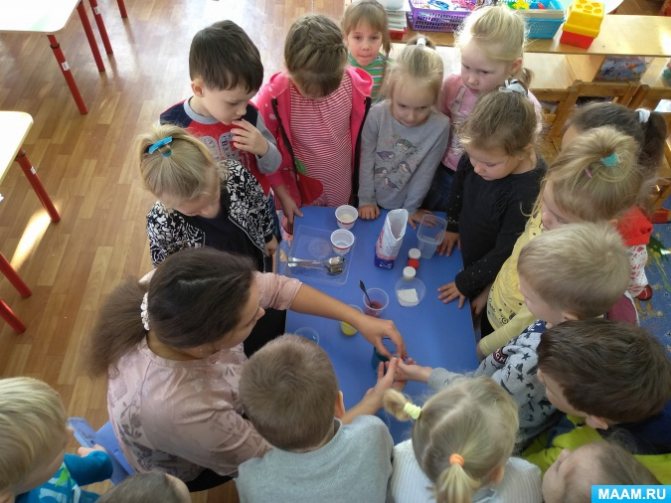
In conclusion, I would like to note that at the stage of completing the preschool level of education, the following indicators can be considered the result of successful work on organizing experimental activities . Firstly, stable motivation to conduct practical research, including in independent activities (on walks, in independent experimentation , at home). Children take the initiative in choosing materials and tools for conducting experiments, ask and solve problematic questions, test their own assumptions experimentally, and strive to complete what they started in order to find out and record the result of the experiment .
Secondly, a high level of children's independence , the range of their interests is expanding, children are proactive in putting forward and testing hypotheses, and are looking for unusual approaches to solving problem situations.
Senior group. Senior preschool age. Children 5-6 years old
Getting to know nature. Card index of experiences and experiments for children of the senior group Experiments with Air “Games with balloons”
Objectives: introduce children to the fact that there is air inside a person and discover it; - develop curiosity and attention; - maintain interest in understanding the surrounding reality by asking problematic questions; -...
Summary of the lesson on FCCM in the senior group “Experiments with water. Water purification" Notes on Forming a holistic picture of the world. " Experiments with water . Water purification"
Objectives: 1. Educational: -With the help of
experimental activities, to promote in older preschoolers ideas about various methods of water purification and the importance of clean water in life...
